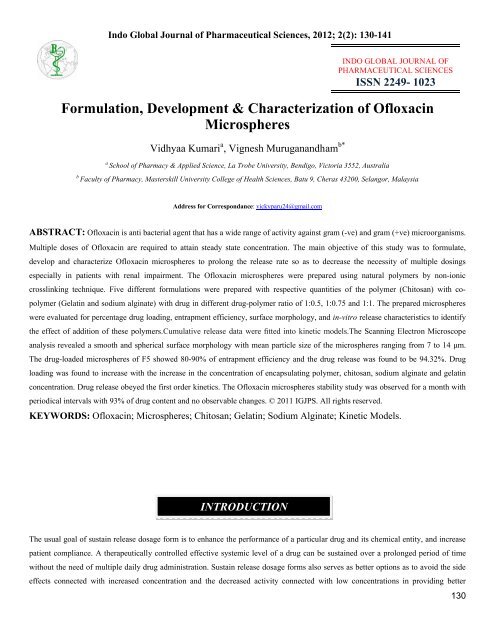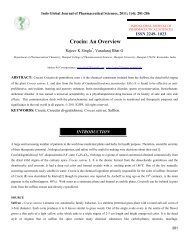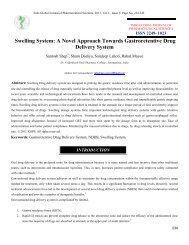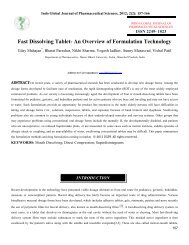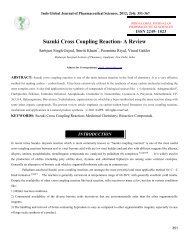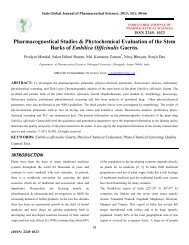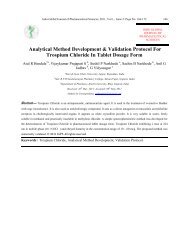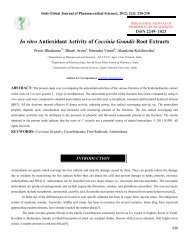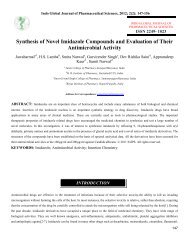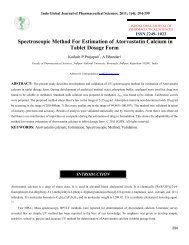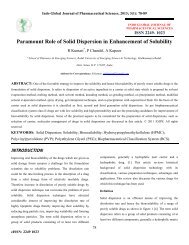Formulation, Development & Characterization of Ofloxacin ...
Formulation, Development & Characterization of Ofloxacin ...
Formulation, Development & Characterization of Ofloxacin ...
Create successful ePaper yourself
Turn your PDF publications into a flip-book with our unique Google optimized e-Paper software.
Indo Global Journal <strong>of</strong> Pharmaceutical Sciences, 2012; 2(2): 130-141<strong>Formulation</strong>, <strong>Development</strong> & <strong>Characterization</strong> <strong>of</strong> <strong>Ofloxacin</strong>MicrospheresVidhyaa Kumari a , Vignesh Muruganandham b*aSchool <strong>of</strong> Pharmacy & Applied Science, La Trobe University, Bendigo, Victoria 3552, AustraliaINDO GLOBAL JOURNAL OFPHARMACEUTICAL SCIENCESISSN 2249- 1023bFaculty <strong>of</strong> Pharmacy, Masterskill University College <strong>of</strong> Health Sciences, Batu 9, Cheras 43200, Selangor, MalaysiaAddress for Correspondance: vickyparu24@gmail.comABSTRACT: <strong>Ofloxacin</strong> is anti bacterial agent that has a wide range <strong>of</strong> activity against gram (-ve) and gram (+ve) microorganisms.Multiple doses <strong>of</strong> <strong>Ofloxacin</strong> are required to attain steady state concentration. The main objective <strong>of</strong> this study was to formulate,develop and characterize <strong>Ofloxacin</strong> microspheres to prolong the release rate so as to decrease the necessity <strong>of</strong> multiple dosingsespecially in patients with renal impairment. The <strong>Ofloxacin</strong> microspheres were prepared using natural polymers by non-ioniccrosslinking technique. Five different formulations were prepared with respective quantities <strong>of</strong> the polymer (Chitosan) with copolymer(Gelatin and sodium alginate) with drug in different drug-polymer ratio <strong>of</strong> 1:0.5, 1:0.75 and 1:1. The prepared microsphereswere evaluated for percentage drug loading, entrapment efficiency, surface morphology, and in-vitro release characteristics to identifythe effect <strong>of</strong> addition <strong>of</strong> these polymers.Cumulative release data were fitted into kinetic models.The Scanning Electron Microscopeanalysis revealed a smooth and spherical surface morphology with mean particle size <strong>of</strong> the microspheres ranging from 7 to 14 μm.The drug-loaded microspheres <strong>of</strong> F5 showed 80-90% <strong>of</strong> entrapment efficiency and the drug release was found to be 94.32%. Drugloading was found to increase with the increase in the concentration <strong>of</strong> encapsulating polymer, chitosan, sodium alginate and gelatinconcentration. Drug release obeyed the first order kinetics. The <strong>Ofloxacin</strong> microspheres stability study was observed for a month withperiodical intervals with 93% <strong>of</strong> drug content and no observable changes. © 2011 IGJPS. All rights reserved.KEYWORDS: <strong>Ofloxacin</strong>; Microspheres; Chitosan; Gelatin; Sodium Alginate; Kinetic Models.INTRODUCTIONThe usual goal <strong>of</strong> sustain release dosage form is to enhance the performance <strong>of</strong> a particular drug and its chemical entity, and increasepatient compliance. A therapeutically controlled effective systemic level <strong>of</strong> a drug can be sustained over a prolonged period <strong>of</strong> timewithout the need <strong>of</strong> multiple daily drug administration. Sustain release dosage forms also serves as better options as to avoid the sideeffects connected with increased concentration and the decreased activity connected with low concentrations in providing better130
Indo Global Journal <strong>of</strong> Pharmaceutical Sciences, 2012; 2(2): 130-141overall therapy. Many drugs require controlled administration into certain conditioned patients such as patient who are undergoingdialysis for renal impairment or for patient who has are hepatically insufficient. This is because the uncontrolled release can render thedrug to be toxic and further harmful to other organs. <strong>Ofloxacin</strong> is a synthetic fluorinated carboxyquinolone that has a broad spectrum<strong>of</strong> activity against both gram-negative and gram-positive bacteria [1]. It is indicated for uncomplicated skin infections, complicatedurinary tract infection, respiratory tract infections and some sexually transmitted diseases [2]. Normal dosage regimen varies from200-600 mg administered twice or thrice a day, depending on severity <strong>of</strong> infection. Biological half-life <strong>of</strong> drug is from 5-6 hrs [3]. Asit requires multiple dosing to obtain the required therapeutic doses and due to the established warnings <strong>of</strong> its dangerous adverseeffects, this drug has been chosen to be the model <strong>of</strong> our study. The formulation <strong>of</strong> sustained release dosage form through the design<strong>of</strong> <strong>Ofloxacin</strong> microspheres could also potentiate the drug’s ability to reduce the development <strong>of</strong> drug resistant bacteria. The coatmaterial can be <strong>of</strong> various types ranging from natural polymers, such as albumin, gelatin [4] chitosan and synthetics such poly (vinylalcohol), poly (Iactide-co-glycolide) and a combination <strong>of</strong> two polymers such as chitosan-sodium CMC, alginate-chitosan [5] oralginate-gelatin. The current method that is being practiced in this study is done with natural polymers. The main advantages <strong>of</strong>natural polymers are that they are biocompatible, biodegradable and produce no systemic toxicity on administration [6].The method isalso easier, convenient, and cost effective, less time consuming and expected to produces an efficient release rate. The polymer that isbeing used in this study is chitosan and co-polymers are gelatin [7] and sodium alginate [8].MATERIALS & METHODSMaterials<strong>Ofloxacin</strong> was obtained as gift sample from Reachem Laboratory chemicals, pvt ltd, Chennai, India. Chitosan, sodium alginate andgelatin was purchased from R &M Chemicals, Essex, UK. All other reagents used were <strong>of</strong> analytical grade.Preparation <strong>of</strong> <strong>Ofloxacin</strong> MicrospheresChitosan-coated alginate-gelatin microspheres <strong>of</strong> <strong>Ofloxacin</strong> were prepared by non-ionic crosslinking method. As presented in Table4.1, five different formulations were prepared with respective quantities <strong>of</strong> the polymer (Chitosan) with co polymer (Gelatin) andsodium alginate with drug in different drug-polymer ratio <strong>of</strong> 1:0.5, 1:0.75 and 1:1. Sodium alginate was dissolved in a 25 ml <strong>of</strong>preheated distilled water <strong>of</strong> about 55°C. Chitosan dissolved in 1-2% <strong>of</strong> acetic acid solution was taken and to that, 100 mg <strong>of</strong> powdered<strong>Ofloxacin</strong> was added and were placed on the sonicator (Elma S80 H Elmasonic) for approximately 15 min with a light stirringoccasionally. This was to ensure that the drug is equally dispersed on the aqueous medium and to remove any air bubbles the resultedfrom the stirring by glass rod. While the solution was still on the sonicator, 2-2.5% <strong>of</strong> gelatin was added and continuously sonicateduntil the gelatin forms a mixture <strong>of</strong> uniform dispersion. By using a 20 gauge sized needle, the drug-polymer mixture was slowly addeddrop wise into 1% <strong>of</strong> Calcium Chloride solution. The microspheres formed are let stand for 10 min before filtering it with Whatmannfilter paper using a vacuum pump. The filtered microspheres were dried at room temperature for 48 hrs as in Table 1.Evaluation and <strong>Characterization</strong> <strong>of</strong> MicrospheresDrug ContentTo prepare a standard solution, 50 mg <strong>of</strong> the <strong>Ofloxacin</strong> drug was dissolved in 50 ml <strong>of</strong> phosphate buffer solution <strong>of</strong> pH 7.4. From thesolution, 1 ml was withdrawn and diluted with 100 ml <strong>of</strong> phosphate buffer.131
Avec eux, pas d’escompte sur d’hypothétiques traites à tirer avec des formules dugenre «sacrifie-toi, fais des efforts, souffre, ça te sera utile plus tard », c’est ici etmaintenant que la classe doit être le lieu de l’expérience sociale d’apprendre et d’yprendre plaisir. On ne la leur fait pas, ils ne sont pas dupes : si ça n’est pas intéressantmaintenant, ça n’a pas d’intérêt du tout ! La petite logique d’investisseur à la petitesemaine qu’on tente d’inculquer en guise d’antalgique à tous ceux que l’école fait souffrirne les touche même pas. La promesse de félicité au paradis du prolétariat précaireobtenue au terme d’une scolarité de souffrance rédemptrice, très peu pour eux. Ils necroupiront pas silencieusement en fond de classe en faisant semblant de croire à lafarce, ils savent, eux, que le roi est nu. Peut-être ont-ils déjà trop bien compris qu’ilsn’ont pas vraiment leur place dans un monde où l’on a de vénération que pour laperformance.Ils savent que venir en classe ne sert pas à cela. Lorsqu’ils en expriment le désir,il semble que pour eux, venir en classe, ce soit approcher un mystère. C’est commepèleriner avec ses pairs vers le mystère des lettres ou des nombres par exemple. Ilssemblent souvent vouloir fréquenter une énigme, en éprouver la résistance, la qualité, leplaisir qu’elle peut procurer lorsqu’on l’affronte. Ils en prennent, je crois, la dimensionanthropologique. Alors, je les accompagne pour les aider à soulever un coin du voile. Jeles regarde avancer. J’essaie de prévenir les difficultés en écartant du chemin lespierres trop aigues, en proposant un détour, en encourageant, en partageant leur joie deprogresser tant soit peu. La pédagogie est-elle un art de péripatéticien ? Personne – pasplus moi que les autres – ne peut savoir ce que chacun attend de ce pèlerinage,jusqu’où il ira, ce qu’il en conservera, ce qui lui servira d’appui pour d’autres conquêtes.Prenons la lecture : qui sait pourquoi certains demandent à apprendre à lire à 16 -17 ans alors qu’ils n’y sont jamais parvenus auparavant, que les tentatives précédentes,lorsqu’il y en a eu, ont été sources de souffrance ? à l’inverse, pourquoi certains neferont jamais cette demande ? pourquoi demander maintenant ? sur la base de quel(s)souvenir(s), avec quelle espérance ? pour quelle idée de ce que c’est que lire et dubénéfice qu’on peut en tirer ?Oui, bien sûr, il y a la part de la pression familiale, de la normativité prescrite parl’environnement social face à quoi, il y a aussi les réticences du milieu pr<strong>of</strong>essionnelmédico-éducatif… mais lorsque les déterminations sont si floues et indécidables, nevaut-il pas mieux renoncer au déterminisme et écouter le sujet qui parle ? Alors, jepréfère dire « oui », dire « viens ». Mon problème de pédagogue devient alors departager avec les uns et les autres cette expérience en sorte que quoi qu’il advienne etqui est imprédictible, ce soit pour chacun une expérience heureuse. Heureuse alorsmême qu’il leur faut consentir à l’effort ; ce que je leur rappelle aussi souvent quenécessaire. Et le plus étrange, c’est qu’il arrive que « ça marche » ! (tout comme il arriveque ça ne marche pas… du moins pas au sens de ce qu’on en attend communément ;mais qui sait si on n’a pas posé une pierre d’attente qui servira un jour ?)Ça marche : disons-le tout de suite, je n’ai aucune gloriole personnelle à en tireret la formule n’est pas que de style, façon fausse modestie. Inutile d’insister, je ne croispas à la magie, s’il y avait un truc, une méthode, ça se saurait.3
In-vitro Drug Release StudiesIndo Global Journal <strong>of</strong> Pharmaceutical Sciences, 2012; 2(2): 130-141Accurately weighed samples <strong>of</strong> the microspheres were added to dissolution medium <strong>of</strong> pH 7.4 buffer [Shaharyar M. et. al., 2006] for24 hrs using dissolution apparatus (USP II TDT-081 Electrolab). Temperature was maintained at 37°C ± 2°C and fluid was agitated at100 rpm. One ml <strong>of</strong> dissolution media was drawn at periodic intervals (2, 6, 8, 12 & 24 hrs) and the withdrawn volumes were replacedwith equal quantity <strong>of</strong> the buffer and the constant volume maintained. After suitable dilution, the samples withdrawn were analyzedspectrophotometrically at 294 nm (Henry A. et. al., 2008) according to Indian Pharmacopoeia 2007 using UV spectrophotometer(JASCO-V500, Japan). The in-vitro dissolution studies were performed in triplicates.<strong>Formulation</strong>CodeDrug :ChitosanSodiumAlginate(%)Gelatin(%)CaCl 2 (%)Citric acid(ml)F1 1 : 0.5 1 - 1 2F2 1 : 0.5 2 2 1 -F3 1 : 0.75 2.5 2.5 1 1F4 1 : 1 3 - 1 1F5 1 : 1 3 2.5 1 2Table 1: Composition <strong>of</strong> microspheres with different ratios <strong>of</strong> drug and polymers<strong>Formulation</strong>Entrapment efficiency Surface MorphologyMean particle size (µm)Code(%) mean± SDF1 7.12±0.89 64.88±3.22 Spherical & smoothF2 9.58±0.61 69.50±0.63 Spherical & smoothF3 11.09±1.22 72.09±1.97 Spherical & smoothF4 10.17±0.87 77.20±2.01 Spherical & smoothF5 13.76±0.43 89.46±0.91 Spherical & smoothTable 2 .Mean Particle size distribution and entrapment efficacyFigure 1: Mean Particle size <strong>of</strong> <strong>Ofloxacin</strong> microspheres (µm)133
Indo Global Journal <strong>of</strong> Pharmaceutical Sciences, 2012; 2(2): 130-141Kinetics <strong>of</strong> Drug ReleaseTo examine the drug release kinetics and mechanism, the cumulative release data were fitted into kinetic models. The zero order rateEq. (5) describes the systems where the drug release rate is independent <strong>of</strong> its concentration [16].The first order Eq. (6) describes therelease from system where release rate is concentration dependent. Higuchi (1963) described the release <strong>of</strong> drugs from insolublematrix as a square root <strong>of</strong> time dependent process based on Fickian diffusion Eq. (7). The Hixson-Crowell cube root law Eq. (8)describes the release from systems where there is a change in surface area and diameter <strong>of</strong> particles or tablets [17].C = k o t ……….. Eq 5Where, K 0 is zero-order rate constant expressed in units <strong>of</strong> concentration/time and t is the time.LogC =LogC 0 kt / 2.303 ……… Eq 6Where, C 0 is the initial concentration <strong>of</strong> drug and K is first order constant.Q = Kt 1/ ………. Eq 7Where, K is the constant reflecting the design variables <strong>of</strong> the system.Q 0 1/3 – Qt 1/3 = K HC t ………. Eq 8Where, Qt is the amount <strong>of</strong> drug released in time t, Q 0 is the initial amount <strong>of</strong> the drug in tablet and K HC is the rate constant forHixson-Crowell rate equation.Time(hrs)Percentage <strong>of</strong> drug release (%)F1 F2 F3 F4 F52 37.55 34.12 28.98 17.34 12.486 68.12 61.98 49.27 32.76 34.038 - 79.78 63.23 49.23 46.6012 - - 89.12 72.34 64.9024 - - 98.12 89.26 94.32Table 3: Percentage <strong>of</strong> drug release from microspheresTime(hrs)√t log t Amountreleased(mg)% drugreleased% drugto bereleasedlog %drugreleasedlog % drugto bereleased(D)⅓2 1.414 0.301 12.48 12.48 87.52 1.096 1.942 4.4396 2.449 0.778 34.03 34.03 65.97 1.532 1.819 4.0408 2.828 0.903 46.60 46.60 53.40 1.668 1.727 3.76512 3.464 1.079 64.90 64.90 35.10 1.812 1.545 3.27424 4.898 1.380 94.32 94.32 05.68 1.974 0.754 1.784Table 4: Calculated drug release kinetics values <strong>of</strong> the formulated <strong>Ofloxacin</strong> Microspheres (F5)Where,D – Percentage drug to be releasedt - Time134
Indo Global Journal <strong>of</strong> Pharmaceutical Sciences, 2012; 2(2): 130-141Korsmeyer–Peppas model describe the mechanism <strong>of</strong> drug release [18].The following plots were made: cumulative % drug release vs. time (zero order kinetic model); log cumulative <strong>of</strong> % drug remainingvs. time (first order kinetic model); cumulative % drug release vs. square root <strong>of</strong> time (higuchi model) log cumulative % drug releasevs. log time (korsmeyer-peppas model) and cube root <strong>of</strong> drug % remaining in matrix vs. time (hixson-crowell cube root law).S. NoPhysical stabilityStorageDrug contentTime (Days)(Visualcondition(%)observation)1 RT Initial 94.32 NOC2 RT 7 th day 94.16 NOC3 RT 14 th day 93.90 NOC4 RT 21 st day 93.47 NOC5 RT 28 th day 93.28 NOCTable 5. Stability studies <strong>of</strong> <strong>Ofloxacin</strong> Microspheres[NOC – No observable changes; RT – Room temperature (25 0 C ± 2 0 C)]Stability studiesThe finalized formulation (F5) <strong>of</strong> microspheres were taken in a crucible and stored at room temperature (25 0 C ± 2 0 C) for 28 days .Thereadings were taken at 7 days at periodical intervals (0 th , 7 th , 14 th , 21th, and 28 th day). The microspheres were analyzedspectophotometrically at 294 nm after proper dilutions to evaluate the drug content. The physical stability was also observedperiodically [3].RESULTS & DISCUSSIONIn this study, attempts have been made to develop and formulate chitosan-coated microspheres by non-ionic cross linking technique.The concentration <strong>of</strong> calcium chloride was retained in all batches. This was to prevent instant gelling <strong>of</strong> sodium alginate on addition <strong>of</strong>calcium chloride and squeezing out <strong>of</strong> the aqueous phase from gel lattice. The influence <strong>of</strong> alginate concentration was evaluated withthree different concentrations (1.0; 2; 2.5; 3.0%).The SEM micrographs and typical surface morphology <strong>of</strong> the microspheres were shown in Figure 4A and Figure 4B. Themicrospheres prepared were spherical with smooth surface. The smooth surface was due to the use <strong>of</strong> optimum concentration ratio <strong>of</strong>calcium chloride as 1% in all batches. As expected, decreasing the alginate concentration decreased the microsphere size. Therefore,an alginate concentration <strong>of</strong> 3% was used in the further preparations.The average particle size <strong>of</strong> microspheres was between 7 to 14 µm which was carried out by using optical microscope fitted with eyepiece micrometer which was then calibrated with stage micrometer.The average size <strong>of</strong> microsphere particles increased withincreasing polymer (chitosan).135
Indo Global Journal <strong>of</strong> Pharmaceutical Sciences, 2012; 2(2): 130-141Figure 2: Mean particle size range <strong>of</strong> 100 <strong>Ofloxacin</strong> microspheres (F5)Figure 3: Percentage <strong>of</strong> drug entrapment efficiencyThe percent encapsulation efficiency was increased up to 89.46 ± 0.91% for F5 with increasing polymer concentration. Thiscan be attributed to the increased availability <strong>of</strong> the polymer for encapsulating the drug, <strong>Ofloxacin</strong>. The high levels <strong>of</strong> sodium alginatelead to increased encapsulation efficiency whereas percentage encapsulation efficiency also increases with the increase in ratio <strong>of</strong>drug-chitosan (1:1).Accurately weighed samples <strong>of</strong> the microspheres were placed into the Visking tube and 1 ml <strong>of</strong> dissolution medium wasallowed to disperse the microspheres inside the tube. Both ends were properly tied with thread and were placed in to the dissolutionmedium <strong>of</strong> pH 7.4 buffer for 24 hrs using dissolution apparatus. The F1 the drug release was found to be improper and has faster136
Indo Global Journal <strong>of</strong> Pharmaceutical Sciences, 2012; 2(2): 130-141Figure 4A: SEM photograph <strong>of</strong> <strong>Ofloxacin</strong> microspheresFigure 4B: Surface <strong>of</strong> <strong>Ofloxacin</strong> loaded microsphere (F5) at 80x137
Indo Global Journal <strong>of</strong> Pharmaceutical Sciences, 2012; 2(2): 130-141Figure 5: Percentage <strong>of</strong> <strong>Ofloxacin</strong> release from microspheres (F5)Figure 6: Zero order Release Model <strong>of</strong><strong>Ofloxacin</strong> Sustained Release formulation (F5)Figure 7: First order Release Model <strong>of</strong> <strong>Ofloxacin</strong> MicrospheresFigure 8: Higuchi Release Model <strong>of</strong> <strong>Ofloxacin</strong>Microspheresrelease within 6 hrs. So the study must be discontinued from proceeding further. The similar kind <strong>of</strong> drug release was formed in F2and it was not so acceptable release as it was within 8 hrs. This study has also been suspended for further. F3, F4 and F5, the drugrelease was continued up to 24 hrs. In all the formulations, with the increase in the polymer concentration, the rate and amount <strong>of</strong> drugrelease was found to be decreased, which can be attributed to the higher binding <strong>of</strong> the drug with the polymer. The release data <strong>of</strong> theformulation, F5 showed better drug loading and release characteristics, and was fitted into the equations <strong>of</strong> various kinetic models.The linear regression value was calculated and it was found to be 0.952, which means <strong>of</strong>loxacin from the microspheres does not obeycontrolled fashion <strong>of</strong> zero-order release. So, the drug release was dependent on the concentration gradient. In the first-order kinetics,the linear regression value was found to be 0.987, which was evident that the release <strong>of</strong> <strong>Ofloxacin</strong> from microsphere obeys first orderkinetics (rate <strong>of</strong> release dependent on concentration gradient). Higuchi equation explains the diffusion controlled release mechanism.The plot was linear and the linear regression coefficient value was 0.993, which was obvious that the drug release obeys diffusionmechanism from the microsphere. The release exponent ‘n’ was found to be 0.832 and the linear regression values from Korsmeyer-Peppas were 0.985. Therefore, this indicates a coupling <strong>of</strong> the diffusion and considerable swelling mechanism—so-called anomalousdiffusion—and may indicate that the drug release was controlled by more than one process. According to Hixson-Crowell equation,the plot was not linear; the linear regression coefficient value was 0.998 that indicates a considerable erosion <strong>of</strong> the microsphere havetaken place during the dissolution process.138
Indo Global Journal <strong>of</strong> Pharmaceutical Sciences, 2012; 2(2): 130-141Figure 9: Korsmeyer-Peppas Release Model <strong>of</strong> <strong>Ofloxacin</strong>MicrospheresFigure 10 : Hixson-Crowell Release Model <strong>of</strong><strong>Ofloxacin</strong> MicrospheresFigure 11: Stability Studies <strong>of</strong> final formulationThe <strong>Ofloxacin</strong> microsphere’s stability was assessed at periodical the intervals through out 28 days and 93% <strong>of</strong> drug content wereobserved at the end <strong>of</strong> one month with no-observable physical changes. The microspheres were analyzed for their drug content. Thisindicates a good stability <strong>of</strong> the <strong>Ofloxacin</strong> microspheres.139
Indo Global Journal <strong>of</strong> Pharmaceutical Sciences, 2012; 2(2): 130-141CONCLUSIONIn this study, the technique that was chosen, non-ionic crosslinking method with the use <strong>of</strong> chitosan as a polymer and gelatin as a copolymer,the F5 was able to sustain the release effectively. It was evident in kinetics equations that the drugs were released inanomalous diffusion with a considerable swelling mechanism. Further studies are needed involving selectively on the in-vivo studiesor develop a correlation between the in-vivo and in-vitro study <strong>of</strong> the release rate <strong>of</strong> <strong>Ofloxacin</strong> microsphere.ACKNOWLEDGEMENTThe authors express their gratitude to the GCEO <strong>of</strong> Masterskill University College <strong>of</strong> Health Sciences, Dato’ Sri Dr. Edmund Santharafor the research funding, Dr. Sudhahar, Mr. Muthappan, Mr. Muthu Mohamed and Dr. Ashok Kumar for their endless support andguidance. The authors are also thankful to the authorities <strong>of</strong> Masterskill University College <strong>of</strong> Health Sciences for providinglaboratory facilities and their constant assistance. The authors are also grateful to Reachem Laboratory chemicals for providing giftsample <strong>of</strong> <strong>Ofloxacin</strong>.REFERENCES[1] J.M.Covino, M. Cummings, B .Smith, S.Benes , K.Draft , M.William. Comparison <strong>of</strong> <strong>Ofloxacin</strong> and Ceftriaxone in the Treatment <strong>of</strong>Uncomplicated Gonorrhea Caused by Penicillinase-Producing and Non-Penicillinase-Producing Strains. Antimicrobial AgentChemotherapy, 1990, 34: 148–149[2] J.H. Yuk, C.H. Nightingale R., Quintiliani and K.R.Sweeney .Bio-vailability and pharmacokinetics <strong>of</strong> <strong>of</strong>loxacin in healthy volunteers.Antimicrobial Agent Chemotherapy., 1991, 35: 384-386[3] A.Arunachalam. B.Stephen Rathinaraj, Subramanian, Prasanta Kumar Choudhury, Kishore A Reddy, Md.Fareedullah. Preparation andevaluation <strong>of</strong> <strong>of</strong>loxacin microspheres using Natural gelatin polymer. International Journal <strong>of</strong> Applied Biology and PharmaceuticalTechnology.,2010,1(1):61-6[4] G.Angela, Hausberge, P.Patrick , DeLuca .<strong>Characterization</strong> <strong>of</strong> biodegradable poly (D,L-lactide-co-glycolide) polymers and microspheres.Journal <strong>of</strong> Pharmaceutical and Biological Analysis. 1995, 13(60):747-760[5] A.K. Anal, D Bhopatkar, S. Tokura, H. Tamura, W.F. Steven. Chitosan–alginate multilayer beads for gastric passage and controlledintestinal release <strong>of</strong> protein. Drug Developement. Industrial Pharmaceutical. 2003, 29, 713–724.[6] S.Takka, F. Acarturk. Calcium alginate microparticles for oral administration. I.Effect <strong>of</strong> sodium alginate type on drug release and drugentrapment efficiency. Journal <strong>of</strong> Microencapsulation.,1999,16:275-290[7] K. Upadhye, S Bakhle, G. Dixit.Preparation and Evaluation <strong>of</strong> Gelatin Microspheres Containing Cipr<strong>of</strong>loxacin Hydrochloride. IndianDrugs., 2004,41(11): 665-668[8] S. Shiraishi, T. Imai, M. Otagiri. Controlled-release preparation <strong>of</strong> indomethacin using calcium alginate gel. Biology and PharmaceuticalBulletin., 1993, 16 (11): 1164–1168[9] A. Semalty & M. Semalty. Preparation and <strong>Characterization</strong> <strong>of</strong> Mucoadhesive Microspheres <strong>of</strong> Cipr<strong>of</strong>loxacin Hydrochloride.IndianDrugs.,2007,44(5): 368-373[10] S.P.Vyas & R.K.Khar .Targeted and Controlled drug delivery. 1 st edition.,2006, 325-326: 417-457[11] M.Alagusundaram, C. Madhu Sudana Chetty, K. Umashankari, Attuluri Venkata Badarinath,C. Lavanya , S. Ramkanth. Microspheres As ANovel Drug Delivery System -A Review International Journal <strong>of</strong> ChemTech and Research.,2009,1(3): 526-534[12] F. Coi, D. Cun , A. Tao, M.Yang , Y.K.Shi and Y.Guan. Preparation and characterization <strong>of</strong> melittin- loaded poly (DL-lactic acid) or poly(DL-lactic –co- glycolic acid )microspheres made by double emulsion method, Journal <strong>of</strong> Controlled release. 2005,107 (2): 310-319.[13] G.T.Kulkarni, K.Gowthamarajan, B.Suresh. Stability testing <strong>of</strong> Pharmaceutical Products: An overview. Indian Journal <strong>of</strong> PharmaceuticsEducation and Research. 2004, 38(11): 194-202.[14] M.Shahar yar, A. Ahamed Siddiqui .Design <strong>of</strong> targeted dosage form <strong>of</strong> <strong>Ofloxacin</strong>. Journal <strong>of</strong> Serbian Chemical Sciences., 2006, 71 (12):1269-1273140
Indo Global Journal <strong>of</strong> Pharmaceutical Sciences, 2012; 2(2): 130-141[15] A.Henry Okeri & M. Ikhuoria Arhewoh. Analytical Pr<strong>of</strong>ile <strong>of</strong> the fluoroquinolone antibacterials.African Journal <strong>of</strong>Biotechnology.,2008,7(6):670-680[16] T.P.Hadjiioannou, G.D. Christian,M. Koupparis, P.E. Macheras. Quantitative Calculations in Pharmaceutical Practice and Research, NewYork: VCH Publishers Inc.,1993,345-348[17] A.W. Hixson and J.H. Crowell. Dependence <strong>of</strong> reaction velocity upon surface and agitation .I. theoretical consideration. Industrial andEngineering Chemical Research.,1931, 23: 923-931[18] R.W. Korsmeyer, R. Gurny, E.Doelker, P. Buri ,N.A.Peppas. Mechanisms <strong>of</strong> solute release from porous hydrophilic polymers. InternationalJournal <strong>of</strong> Pharmaceutics., 1983, 15: 25.Indo Global Journal <strong>of</strong> Pharmaceutical Sciences( ISSN 2249 1023 ; CODEN- IGJPAI)indexed and abstracted in EMBASE(Elsevier), SCIRUS(Elsevier), Chemical AbstractServices(CAS), American Chemical Society(ACS), Index Copenicus, EBSCO, DOAJ,Google Scholar and many more. For further details, visit http://iglobaljournal.com141


